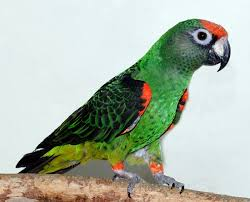Jardine’s Parrot

Description
The Jardine's parrot (Poicephalus gulielmi), also known as the red-fronted parrot, is a medium-sized mainly green parrot endemic across wide areas of Africa. It has three subspecies. The extent and shade of the red or orange plumage on its head, thighs, and bend of wings vary depending on the subspecies.
They are popular as pets, partly because of their ability to mimic speech and copy sounds. Trapping of wild birds for the pet trade is a potential threat to wild populations; however, they are protected by CITES (appendix II) making the trade, import and export of all wild-caught parrots illegal.
The red-fronted parrot is 28 cm (11 in) long. It is mostly green and has a short black squarish tail. Black feathers on the head, neck, back, and wings have lighter green edges giving a scalloped appearance. The lower mandible is dark grey and the upper mandible has a horn coloured base and a dark grey tip. The irises are red-orange, the eyerings are pinkish-grey, and the legs are grey-brown. The amount of red or orange on the forecrown, the bend of the wing, and thighs varies in the three subspecies but is absent in all young birds - juveniles having a dark smokey appearance above a paler beak and brown irises. The adult male and female are identical in external appearance.[2] Gender determination of chicks is normally carried out by breeders using DNA analysis of a feather sample or by internal examination of the cloaca. This latter method is cheaper and quicker but does cause some distress to the bird.
Scientific Name
Poicephalus Gulielmi
Country Of Origin
Central Africa
Size
Life Expectancy
Noise Level
Moderate
Talk / Trick Ability
Fair; good mimic
Characteristics
Jardine’s parrots are quite acrobatic and enjoy entertaining their owners with newly devised tricks. They’re also highly intelligent and benefit from frequent interaction with their humans. Jardine’s parrots are known for getting involved in games of hide and seek and have been seen using newspaper covering the bottom of their cage to hide under or roll into a tube for hiding. These playful pet birds can be tricksters, twisting themselves into odd positions or lying on their backs in the cage to get a reaction from the owner. When a Jardine’s parrot sees its owner watching them play, they will often begin playing even more to entertain or convince the owner to get involved in their fun. Jardine’s parrots are said to have the comical, playful and animated personality of larger parrots, but without the cost, mess or noise typically associated with bigger pet parrots.
Behavior / Health Concerns
Jardine’s parrots love to talk, and its mimicking ability is close to an African grey’s. They have a pleasant voice, and are gifted whistlers. Jardine’s parrots are known for staying motionless, but get rowdy during playtime. They also go through a nipping stage when they are young, but with proper handling and training, owners can minimize the “teething” as their birds mature. A Jardine’s parrot’s beak can become overgrown, so provide plenty of wood and other hard toys to chew on. Poicephalus parrots thrive on a pellet-based diet along with fresh fruits, vegetables and greens.
Expert Advice
“The Jardine’s love to lay on their backs and play with their toys. While all Poichephalus are capable of speaking, most of them have what sound like ‘computer generated’ squeaky little voices, unlike their bigger African cousins the greys, whose speaking voices sound just like their humans.”
Bonnie Kenk, Peace Parrot Education and Adoption Center founder and executive director